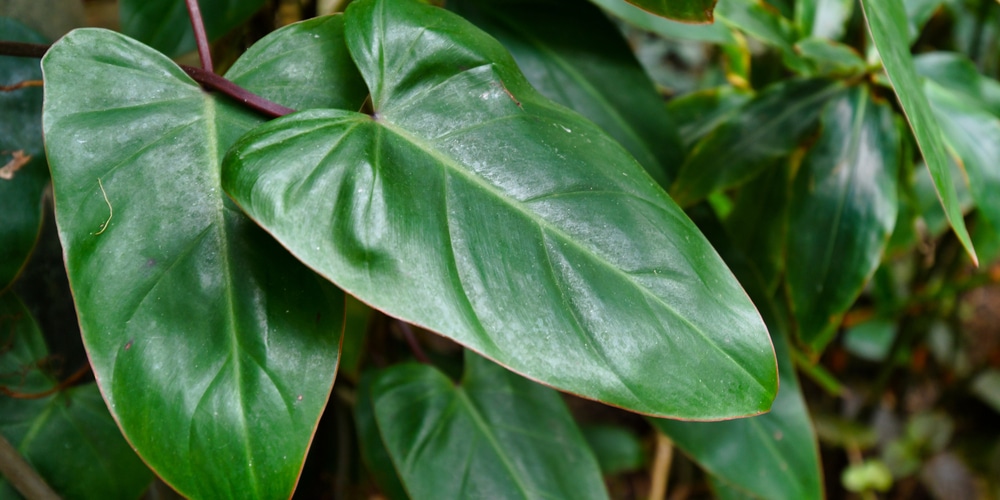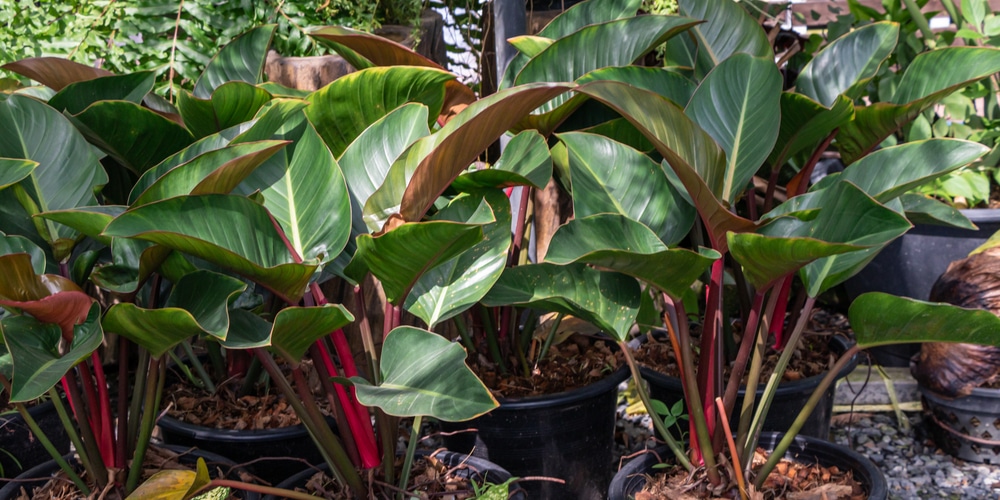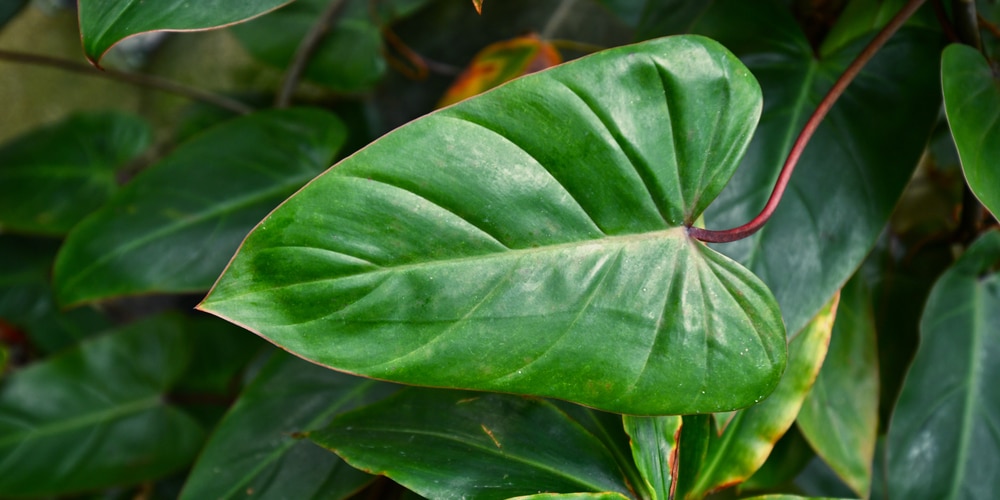Blush Philodendron is a lush and dense-growing houseplant that can brighten up any corner of your house, no matter where you put it. As the name suggests, this variety of philodendrons displays a reddening or blushing side, on the stems, for a dramatic (and appealing) contrast.
The foliage is glossy, heart-shaped, and bright green. Because of its climbing nature, this plant does well around support structures to grow vertically. And the good news is that, under optimal conditions, you won’t struggle to have Blush Philodendron thrive in your house. But keep reading to learn more about this aesthetically appealing plant!
| Botanical Name | Philodendron Erubescens |
| Common Name | Blush Philodendron |
| Plant Type | Perennial |
| Flower Color | Flowering is rare, especially indoors. Blooms come out in a spathe and spadix structure and are pink or bright red. They usually don’t last more than two to three days. |
| Size When Mature | 24-36 inches |
| Bloom Time | Between May to July |
| Sun Requirements | Medium to bright indirect light. |
| USDA Hardiness Zones | 10-11 |
| Soil PH Range | 5.8-7.5 |
| Soil Type | Well-draining, good aeration, slightly acidic to neutral |
| Water Needs | Medium (leave the soil dry between waterings) |
| Native Area | Central and South America |
What you Need to Know About Blush Philodendrons
Under ideal conditions, the elongated leaves of this type of philodendron can measure about 10-inches long. As the leaves emerge, they often come out reddish and turn green as they mature. Consider placing a moss stick on the container to support your plant’s vertical structure: the results will be stunning!
Keep in mind that you might never see your Blush Philodendron flowering if you are growing it indoors. And even outside, blooming is a rare sight.
The plants are native to the tropical forests of Central and South America, which is why they prefer warmth and humidity. They are easy to grow as houseplants, but you can also plant them outdoors, as long as you live in a hot region.
If you have pets or kids running around your house, you prevent them from getting close to this plant. Philodendrons are toxic to humans and animals. After ingestion, they can cause various reactions (including swelling lips, tongue, throat and vomiting, and diarrhea).
How to Care for a Blush Philodendron
But what does it mean to take care of a Blush Philodendron? How can you recreate the optimal conditions for it to thrive in your house? Keep reading to learn everything you need to know about growing and caring for a thriving Blush Philodendron!
Light
These plants thrive in indirect sunlight. Consider placing yours next to east or south-facing windows, but add some sheer curtains to avoid burning its leaves. Ideally, locate them in the middle of a bright room: the lighting will be more than enough. Anywhere between 10 and 12 feet from a window will work.
If you are growing your philodendron outdoors, you might have to protect it from the harsh rays of the afternoon sun. Avoid direct sunlight, as exposure can cause your plant’s leaves to turn yellow or brown. Keep your philodendron under a canopy or a similar structure for best results.
Water and Soil Needs
These plants are drought tolerant and sensitive to overwatering. So, it will be best to water them staying on the conservative side. As a rule of thumb, let the soil dry between waterings. Feel it with your fingers to prevent making mistakes: if it seems moist, wait a couple of days longer.
Choosing a potting mix is crucial to avoid letting your plants sit on soggy soil. Blush philodendrons prefer well-draining soil and do best in slightly acidic to neutral conditions. Avoid heavy or sandy soils: they will either retain too much water or drain too quickly. In the first case, you’ll put your plants at risk of root rotting. In the latter case, your plants won’t be able to absorb enough water and nutrients, which will cause them to stop growing. You can use an orchid or a succulent mix. Alternatively, you can combine peat and perlite.
Temperature Requirements

More importantly, this plant won’t survive with frost. You can only grow your Blush Philodendron outdoors if you live in USDA hardiness zones between 10 and 11. In other parts of the country, you might be able to grow it outside during the summer, but you will have to bring it inside as soon as the temperatures drop.
Don’t forget about humidity! If you can, keep the leaves about 50%. Consider purchasing a humidifier for best results. Also, if you live in a dry and hot area, mist your plant’s leaves from two to three times a week. Adding mulch around your plant might help keep moisture longer and regulate the soil temperature.
Fertilizer
Blush philodendrons are fast growers: you will need to add regular fertilizer once a month between spring and summer. Apply a balanced fertilizer to boost leaf production and speed up your plants’ development.
Common Diseases
With this plant, besides making sure not to overwater it, you’ll also have to keep an eye out for diseases. Attacks from mealybugs, aphids, whiteflies, and scales are common. Inspect your plant regularly to take prompt action as soon as you notice something off. The sooner you act, the fewer the risk of infestation. Apply neem oil or insecticidal soap to the damaged leaves and reapply until you see no more insects.
Blush Philodendron Propagation
Blush philodendron is easy to propagate. You can grow more than one plant from the same individual. The best way to do so is to take stem cuttings. Take a couple of healthy-looking stems from your plant with at least two or three leaves. Plant them in a well-draining potting mix and keep them moist. Locate them in a warm and humid location with indirect light.
Consider adding a plastic bag around your plant to maintain moisture and keep it warm. Under optimal conditions, it will take about a month for roots to grow. As you notice your plant outgrowing the container, repot the plant in a bigger one.
How to Prune a Blush Philodendron
Pruning is a practice that can help you keep your plants healthy. Eliminate dead and unhealthy-looking branches to make room for new growth and ensure proper airflow. Doing so will make your plant denser and minimize the risk of diseases and attacks from pests.
Also, you might need to trim your plant once in a while to maintain it in an attractive shape.

